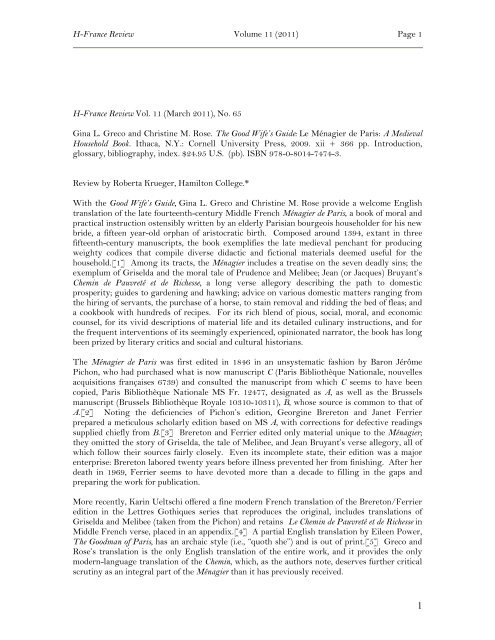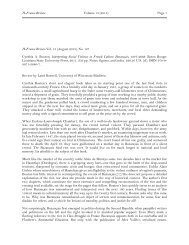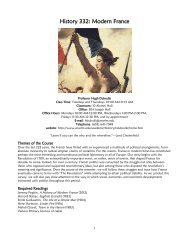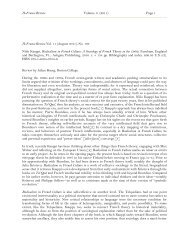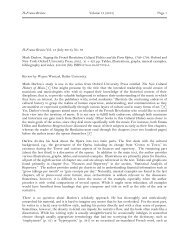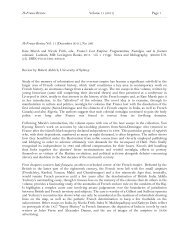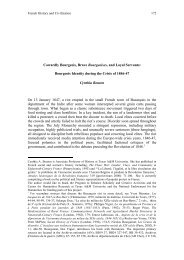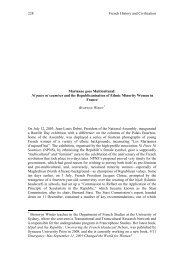Review - H-France
Review - H-France
Review - H-France
You also want an ePaper? Increase the reach of your titles
YUMPU automatically turns print PDFs into web optimized ePapers that Google loves.
H-<strong>France</strong> <strong>Review</strong> Volume 11 (2011) Page 1<br />
H-<strong>France</strong> <strong>Review</strong> Vol. 11 (March 2011), No. 65<br />
Gina L. Greco and Christine M. Rose. The Good Wife’s Guide: Le Ménagier de Paris: A Medieval<br />
Household Book. Ithaca, N.Y.: Cornell University Press, 2009. xii + 366 pp. Introduction,<br />
glossary, bibliography, index. $24.95 U.S. (pb). ISBN 978-0-8014-7474-3.<br />
<strong>Review</strong> by Roberta Krueger, Hamilton College.*<br />
With the Good Wife’s Guide, Gina L. Greco and Christine M. Rose provide a welcome English<br />
translation of the late fourteenth-century Middle French Ménagier de Paris, a book of moral and<br />
practical instruction ostensibly written by an elderly Parisian bourgeois householder for his new<br />
bride, a fifteen year-old orphan of aristocratic birth. Composed around 1394, extant in three<br />
fifteenth-century manuscripts, the book exemplifies the late medieval penchant for producing<br />
weighty codices that compile diverse didactic and fictional materials deemed useful for the<br />
household.[1] Among its tracts, the Ménagier includes a treatise on the seven deadly sins; the<br />
exemplum of Griselda and the moral tale of Prudence and Melibee; Jean (or Jacques) Bruyant’s<br />
Chemin de Pauvreté et de Richesse, a long verse allegory describing the path to domestic<br />
prosperity; guides to gardening and hawking; advice on various domestic matters ranging from<br />
the hiring of servants, the purchase of a horse, to stain removal and ridding the bed of fleas; and<br />
a cookbook with hundreds of recipes. For its rich blend of pious, social, moral, and economic<br />
counsel, for its vivid descriptions of material life and its detailed culinary instructions, and for<br />
the frequent interventions of its seemingly experienced, opinionated narrator, the book has long<br />
been prized by literary critics and social and cultural historians.<br />
The Ménagier de Paris was first edited in 1846 in an unsystematic fashion by Baron Jérôme<br />
Pichon, who had purchased what is now manuscript C (Paris Bibliothèque Nationale, nouvelles<br />
acquisitions françaises 6739) and consulted the manuscript from which C seems to have been<br />
copied, Paris Bibliothèque Nationale MS Fr. 12477, designated as A, as well as the Brussels<br />
manuscript (Brussels Bibliothèque Royale 10310-10311), B, whose source is common to that of<br />
A.[2] Noting the deficiencies of Pichon’s edition, Georgine Brereton and Janet Ferrier<br />
prepared a meticulous scholarly edition based on MS A, with corrections for defective readings<br />
supplied chiefly from B.[3] Brereton and Ferrier edited only material unique to the Ménagier;<br />
they omitted the story of Griselda, the tale of Melibee, and Jean Bruyant’s verse allegory, all of<br />
which follow their sources fairly closely. Even its incomplete state, their edition was a major<br />
enterprise: Brereton labored twenty years before illness prevented her from finishing. After her<br />
death in 1969, Ferrier seems to have devoted more than a decade to filling in the gaps and<br />
preparing the work for publication.<br />
More recently, Karin Ueltschi offered a fine modern French translation of the Brereton/Ferrier<br />
edition in the Lettres Gothiques series that reproduces the original, includes translations of<br />
Griselda and Melibee (taken from the Pichon) and retains Le Chemin de Pauvreté et de Richesse in<br />
Middle French verse, placed in an appendix.[4] A partial English translation by Eileen Power,<br />
The Goodman of Paris, has an archaic style (i.e., “quoth she”) and is out of print.[5] Greco and<br />
Rose’s translation is the only English translation of the entire work, and it provides the only<br />
modern-language translation of the Chemin, which, as the authors note, deserves further critical<br />
scrutiny as an integral part of the Ménagier than it has previously received.<br />
1
H-<strong>France</strong> <strong>Review</strong> Volume 11 (2011) Page 2<br />
In the Good Wife’s Guide, Greco and Rose convey in clear, fluid prose the distinct registers of a<br />
diverse work that ranges from pious exhortations and Biblical exempla to fabliau-like tales,<br />
veterinary remedies, and flavorful recipes and whose narrative voice alternately expresses<br />
religious reverence, patriarchal authority, masculine anxiety, husbandly solicitude, and a<br />
sometimes obsessive attention to domestic details. Selective spot-checking suggests that this<br />
translation is highly reliable. My only significant quibble is not with the text itself, but with the<br />
authors’ misleading explanation in their introduction of the Middle French title, Le Ménagier de<br />
Paris. They claim that this “means [sic] The Parisian Household Book” (p. 2). Yet they<br />
accurately translate the term “nouvel mesnagier” in the Chemin de Pauvreté et de Richesse as<br />
«newly made head of household » (p. 185). In both cases, “ménagier” refers to a person, not to a<br />
book.[6] “The Parisian Householder” would be a more accurate literal translation of Le<br />
Ménagier de Paris. Eileen Power’s somewhat antiquated “Goodman of Paris” is not far from the<br />
mark. Fortunately, the title chosen for the authors’ own translation, The Good Wife’s Guide…A<br />
Medieval Household Book, neatly describes both the function of the book and its intended<br />
audience.<br />
The authors have wisely eschewed archaic language and aimed for clarity and simplicity in<br />
modern English. I found myself wishing that they had retained the term “Distinction” to<br />
describe the book’s major divisions and that they had kept French nomenclature Griseldis and<br />
Gautier for Griselda and Walter, as they do for most of the Ménagier’s named figures, so that<br />
these characters might be more easily distinguished from those in the Clerk’s Tale and in<br />
Boccaccio. But these are minor matters of taste. Greco and Rose deserve our thanks for making<br />
this important late medieval tract available in its entirety to students who do not read modern<br />
French. (Those who read French should use Ueltschi’s translation for all but the Chemin, since<br />
her version is closer in style and lexicon to the original Middle French, reproduced on the<br />
facing page.) Thanks are due also to Cornell University Press for making the book available in<br />
a handsome, reasonably-priced paperback edition so that it may find its rightful place as<br />
assigned or recommended reading in courses on Medieval History, Medieval European<br />
Literature, and Women’s Studies.<br />
The Greco/ Rose translation is accompanied by a lengthy introduction, a glossary of culinary<br />
terms, and a bibliography of editions, dictionaries, and critical works consulted. The<br />
Introduction provides a thoughtful discussion of the narrator’s literary enterprise and domestic<br />
agenda, offers an overview of conduct books and literary sources, and concludes with a lengthy<br />
comparative analysis of the Ménagier’s Griselda exemplum and Chaucer’s Clerk’s Tale. The<br />
extent of this last section, which comprises one third of the entire introduction, suggests that<br />
the authors address their translation primarily to students of medieval English literature.<br />
Although these pages contain much that is helpful and stimulating, students unfamiliar with<br />
continental literature might have been better served by a more streamlined presentation that<br />
would have placed the Ménagier more precisely in its French context. Medieval conduct books<br />
might have been more coherently presented in chronological order in “Contexts: Conduct Books<br />
and Household Books” (pp. 18-28), with description of their specific milieu, generic register, and<br />
audience, and with complete bibliographical references for all editions cited.[7] One<br />
understands the desire not to overburden the bibliography of a translation for English-speaking<br />
students with French criticism in French or English. But since some quite specialized studies<br />
are included (among them an inaccessible conference paper given by Greco on the Jehan de<br />
Saintré, a didactic work composed more than half a century after the Ménagier), it is surprising<br />
to find no mention of classic works such as those by Alice Hentsch (on medieval didactic<br />
literature for women),[8] Elie Golenistcheff-Koutouzoff (on the Griselda story in late medieval<br />
<strong>France</strong>),[9] and Diane Bornstein (on medieval courtesy books).[10]<br />
2
H-<strong>France</strong> <strong>Review</strong> Volume 11 (2011) Page 3<br />
Students will no doubt be unaware of the introduction’s lacunae and occasional<br />
misrepresentations of French material. But some professors may be disconcerted to find<br />
Christine de Pizan described as “bluestocking” (p. 23), an often pejorative term unfortunately<br />
associated with Gustave Lanson’s infamous dismissal of her as a mediocre “bas bleu.”[11] If<br />
Christine may have known Le Ménagier, her career did not exactly “coincide,” as the authors<br />
claim, with its composition (p. 23, n. 35); Christine’s most important didactic works were<br />
written at least a decade later than the household book, and her career extended until 1430.<br />
Rose and Greco offer a strong interpretation of this work, underlined by occasional broad<br />
sweeps that deserve closer scrutiny: e.g., “Men in the book are angry or potentially angry all the<br />
time” (p. 41). Their comparative analysis of the Clerk’s Tale and the Ménagier, which contributes<br />
to the extensive critical discussion that accompanies Chaucer’s retelling, seems better suited for<br />
a scholarly article than for a general introduction. Instructors might have preferred a sparser<br />
approach that would encourage students to attend to the subtleties of both texts and draw their<br />
own conclusions.<br />
Since Greco and Rose delve into considerable detail about the Griselda story, one wishes that<br />
this fecund tradition were presented with greater clarity and scope. A fuller, more precise<br />
account of the story’s evolution from Boccaccio’s vernacular Italian tale to Petrarch’s Latin<br />
translation, to the various French versions, including that of Philippe de Mezières (source for<br />
the Ménagier) and the anonymous Griseldis to Chaucer’s Clerk’s Tale (which draws on Petrarch<br />
and the anonymous French version)—with references to appropriate editions and translations—<br />
would have been helpful for students new to this material. The authors’ discussion (pp. 28-29)<br />
and footnote (p. 29, n. 43) are confusing and potentially misleading, since they imply that Le<br />
Ménagier de Paris is considered to be one of Chaucer’s sources. Without providing a specific<br />
page reference, Greco and Rose state that J. Burke Severs “...notes that several details in the<br />
Clerk’s Tale are likely from the Ménagier and not another French source, and he posits that<br />
Chaucer indeed knew the text” (p. 29, n. 43). Yet if one consults Severs’s The Literary<br />
Relationships of Chaucer’s “Clerk’s Tale,” one finds an entire chapter devoted to a meticulous<br />
comparative analysis of the anonymous Griseldis, the Ménagier’s Griselda, and the Clerk’s Tale.<br />
Severs concludes that, in the light of “overwhelming evidence… not Le Ménagier, but the<br />
anonymous translation, constituted Chaucer’s additional source for the Clerkes Tale.”[12]<br />
Textual evidence aside, it seems unlikely that a text written around 1394 would have been a<br />
source for The Clerk’s Tale; Chaucer’s putative French travels occurred more than a decade<br />
earlier, and there is no evidence that The Ménagier, whose extant manuscripts are all<br />
Burgundian, circulated in England<br />
Although such matters are important to scholars, they need not be rehearsed for students, and<br />
in any case they don’t alter the importance of the Ménagier and its counterparts in the late<br />
medieval literary landscape. Even if Chaucer did not know the Ménagier de Paris, he may well<br />
have known a similar didactic compilation for women. As Golenistscheff-Koutouzoff<br />
demonstrates, the Griselda story circulated in seventeen manuscripts from the late-fourteenth<br />
and fifteenth centuries, among them six that also contained Le Livre du Chevalier de la Tour<br />
Landry, composed in 1372 (Golenistscheff-Koutouzoff, pp. 33-42). That most of these<br />
manuscripts post-date the Ménagier does not preclude the existence of an earlier copy that<br />
Chaucer may have known. Whether or not the Ménagier author “reinvents the conduct book as a<br />
gloss on the figure of Griselda,” as the authors claim in their concluding remarks (p. 43), his<br />
inclusion of Griselda as a model of patience and obedience within the household was common<br />
practice for other late medieval moralists. Indeed, the narrator tells his wife that he seeks to tell<br />
her the story so that she will know what others know: “Since others are familiar with it, I very<br />
much wish that you also may be familiar with it and be able to converse about such things as<br />
3
H-<strong>France</strong> <strong>Review</strong> Volume 11 (2011) Page 4<br />
everybody else does” (p. 119). Viewed in this light, the author’s inclusion of her story seems less<br />
a reinvention of the conduct book than an act of conspicuous cultural imitation.<br />
A word must be said about Greco and Rose’s representation of previous scholarship on this<br />
weighty tome. Even as they acknowledge their reliance on Brereton and Ferrier’s edition and<br />
notes, the translators seem unnecessarily dismissive of their predecessors’ efforts. They assert<br />
that the Brereton/ Ferrier edition “presents an incomplete version of the work” and “feels<br />
disordered and misrepresented [sic]” (p. 4) because it does not include Griselda, Melibee, and<br />
the Chemin de Pauvreté et de richesse. The Oxford edition would have been undeniably enhanced<br />
(and more expensive to produce) had it included the entire compilation. But Greco and Rose<br />
overstate the case when they claim that Brereton and Ferrier did not feel that these texts were<br />
“an essential part” of the work (p. 4). In fact, the editors devote an appendix to a meticulous<br />
comparison of Philippe de Mezières’s and the Ménagier’s versions of Griselda (Brereton and<br />
Ferrier, Menagier, pp. 332-5). Their critical articles, cited in the bibliography, analyze the book’s<br />
didactic sources as integral to the householder’s moral project. Since Brereton and Ferrier<br />
present the text in the order that it appears in the base manuscript (with folios numbers<br />
indicated in parentheses), it is hard to understand the translators’ claim that their work feels<br />
“disordered.” I have found the edition, on the contrary, very well organized for ease of reference<br />
to manuscript A.<br />
Furthermore, Greco and Rose fail to credit their predecessors’ significant contributions in<br />
establishing the critical framework of Le Ménagier de Paris. Claiming that the Ménagier has “in<br />
the past primarily been admired for its antique horticultural and culinary matter” (p. 2), Greco<br />
and Rose imply that they are among the first to read it as “a moral treatise” (p. 2). It may be<br />
true that Pichon (in 1846) and Powell (in 1928) were especially intrigued by the compilation’s<br />
domestic details, which are absent from other notable medieval works on female conduct, such<br />
as the Livre du Chevalier de la Tour Landry or Christine de Pizan’s Livre des trois vertus. But to<br />
suggest that neither Brereton and Ferrier nor Uelstchi appreciated the Ménagier as a book<br />
exhorting proper moral values and social behavior does a grave disservice to their scholarship.<br />
Brereton’s and Ferrier’s extensive scholarly excavations turned up not only detailed information<br />
about gardening, hawking and cooking in medieval <strong>France</strong>, but also a wealth of didactic literary<br />
sources, cited in abundant, meticulous footnotes and discussed at length in their Introduction<br />
(“The Author and His Wife;” “The Author’s Ideal of Marriage;” “Biblical and Literary Sources<br />
for the First Distinction” pp. xxi-xxxix). Indeed, Brereton and Ferrier argue strongly that the<br />
material of the First Distinction (the moral treatise) is just as important as that of the Second<br />
Distinction. They urge readers “….to consider the book as a whole, since for the author the<br />
moral and spiritual teaching and the practical instruction are inseparable and equally important<br />
guides to success in matrimony” (p. xxx). Contemporary critics may disagree with Brereton and<br />
Ferrier’s depiction of the “salutary” view of marriage offered by the Ménagier (p. xxx) and may<br />
object to their portrayal of the husband as a contented, kindly spouse. But readers of any<br />
version of Le Ménagier de Paris owe a huge debt to Brereton and Ferrier for establishing the<br />
literary and cultural milieu in which the putative “good wife” would have received her moral<br />
instruction. Their edition remains the cornerstone for scholarship on this work.<br />
Greco and Rose mention that they have consulted Ueltschi’s translation, but they appear to<br />
have taken scant notice of her fine introduction. Author of a comparative study of medieval<br />
French didactic literature, Ueltschi is well positioned to present Le Ménagier in a sophisticated<br />
critical framework.[13] She is among the first critics to venture the hypothesis that the<br />
husband/wife relationship in the frame is a mere literary device, “une simple simulation au<br />
service d’un projet littéraire” (Ueltschi, p. 9), an insight apparently overlooked by Greco and<br />
Rose who claim that “virtually everyone writing on Le Ménagier de Paris has accepted its author<br />
as who he claims to be” (Greco and Rose, p. 10). Ueltschi’s introduction suggests that the<br />
4
H-<strong>France</strong> <strong>Review</strong> Volume 11 (2011) Page 5<br />
work’s tensions and complexities may arise from the contradictions of a fictional narrator whose<br />
attitude towards his spouse ranges from indulgence to intransigence and who displays both<br />
humanism and bourgeois conformity (Ueltschi, p. 10). It is unfortunate that Greco and Rose do<br />
not convey some sense of her perceptive, nuanced arguments to their anglophone audience. In<br />
any case, since Ueltschi’s translation was published fifteen years ago, it must be conceded that<br />
the Ménagier de Paris has been widely received among French scholars as an intriguing and<br />
rhetorically complex moral treatise for some time.<br />
The critical apparatus contains a fair number of errors and inconsistencies. For example, the<br />
authors refer correctly at one point to the pseudo-Aristotelian Economics (p. 40, n. 6) and at<br />
another point, incorrectly, to “Aristotle’s Economics,” (p. 20, n. 27). For this important work,<br />
students should be referred to the Menut edition of Oresme’s French translation of the Livre<br />
yconomique, which has a fine English translation.[14] The bibliography contains several<br />
incomplete or inaccurate entries, the most baffling of which is the attribution of Jane Chance<br />
instead of E. Jane Burns as editor of Medieval Fabrications (an error repeated on p. 29). Some<br />
oddities seem to be the product of a computer-generated bibliography program (e.g., Epopée des<br />
courges: cultures et consommations en Europe, La). It is unfortunate that more editorial attention<br />
was not paid to the critical frame so that it could have been as clear and accurate as the<br />
translation appears to be.<br />
Despite these shortcomings, this book is a valuable resource for teachers of medieval literature<br />
and history. The Good Wife’s Guide presents in English one of the most intriguing<br />
representations of medieval domestic life and provides a lively example of the complex mix of<br />
profane and religious, practical and moral materials that constitute the late medieval household<br />
book. Although they should consult the introduction and notes with caution, students will find<br />
a highly readable treatise that overflows with interesting topics for further research, a text that<br />
can fruitfully be compared to any number of medieval literary works, or that can be productively<br />
studied in courses on medieval European culture and history. Scholars unversed in modern<br />
French will find a helpful accompaniment to the Brereton/Ferrier edition, which remains<br />
unsurpassed as the foundation for scholarly research and critical analysis.<br />
*This review was originally submitted in December 2009.<br />
NOTES<br />
[1] Greco and Rose report the existence of a fourth early sixteenth-century manuscript,<br />
Luxembourg MS I:95 (ancient numéro 19), which they were unable to examine directly; The<br />
Good Wife’s Guide, p. 2.<br />
[2] Le Ménagier de Paris: traité de morale et d'économie domestique composé vers 1393 par un<br />
bourgeois parisien, ed. Jérôme Pichon, 2 vols. (Paris : Crapelet et Lahure, 1846).<br />
[3] Le Menagier de Paris, eds. Georgine E. Brereton and Janet M. Ferrier (Oxford: Oxford<br />
University Press, 1981).<br />
[4] Le Mesnagier de Paris, eds. Georgina (sic) E. Brereton and Janet M. Ferrier, transl. Karin<br />
Ueltschi, Lettres gothiques (Paris: Librairie Générale Française, 1994).<br />
[5] The Goodman of Paris (Le Ménagier de Paris): A Treatise on Moral and Domestic Economy by A<br />
Citizen of Paris (c. 1393), ed. and trans. Eileen Power (London: Routledge, 1928).<br />
5
H-<strong>France</strong> <strong>Review</strong> Volume 11 (2011) Page 6<br />
[6] The first definition of “mesnagier,” according to Godefroy, is a “habitant,” resident,<br />
inhabitant; in six fourteenth- and fifteenth- century examples, this is clearly the meaning; the<br />
second definition is “ouvrier,” worker; and the third is “”économe, administrateur,” economist or<br />
administrator. Frédéric Godefroy, Dictionnaire de l’ancienne langue française et de tous ses dialectes<br />
du IXe au XVe siècle, vol. 5 (Paris : Vieweg, 1888), pp. 293-4.<br />
[7] In one instance of such lack of precision, the authors begin their list of conduct books with<br />
Christine de Pizan’s Treasury of the City of Ladies, which dates from 1405, and end with Philippe<br />
de Mezières’s Livre de la vertu du sacrament de mariage, which was written more than twenty<br />
years earlier. They cite the English title of The Book of the Knight of the Tower, providing in the<br />
bibliography only Caxton’s edition, which was translated and printed in 1484. The version<br />
closer to the Ménagier is the original French text composed in 1372 by Geoffroy de la Tour-<br />
Landry, Le Livre du Chevalier de la Tour Landry pour l’enseignement de ses filles, ed. Anatole de<br />
Montaiglon (Paris : P. Jannet, 1854 ; reprt. Millwood, NY : Kraus, 1982).<br />
[8] Alice Hentsch, De la littérature didactique du moyen âge s’adressant spécialement aux femmes<br />
(Cahors : Couselant, 1903 ; reprint Geneva : Slatkine, 1975).<br />
[9] Elie Golenistcheff-Koutouzoff, L’Histoire de Griseldis en <strong>France</strong> au XIVe et au XVe siècle<br />
(Paris : Droz, 1933).<br />
[10] Diane Bornstein, The Lady in the Tower: Medieval Courtesy Literature for Women (Hamden,<br />
Conn.: Archon Books, 1983).<br />
[11] Charity Cannon Willard first drew English readers’ attention to what she calls Lanson’s<br />
“ill tempered observation” that categorized Christine as (in Willard’s translation of his words)<br />
“the first in that line of insufferable bluestockings whose indefatigable facility was equaled only<br />
by her universal mediocrity;” Charity Cannon Willard, Christine de Pizan: Her Life and Works<br />
(New York: Persea Books, 1984), p. 222. I am sure that the translators did not intend to<br />
disparage Christine. However, for Christine scholars the term “bluestocking” has a strongly<br />
pejorative ring.<br />
[12] J. Burke Severs, The Literary Relationships of Chaucer’s Clerkes Tale (Hamden, Conn.:<br />
Archon Books, 1972), p. 176. In a more recent review of Chaucer’s sources, Amy Goodwin states<br />
that “Severs suggests that Chaucer may [emphasis mine] have been familiar with the adaptation<br />
of Philippe’s translation by the compiler of the Ménagier de Paris, for there are a few details<br />
contained in the Clerk’s Tale some which originate in Philippe’s translation and others which are<br />
thought to be unique to Le Ménagier de Paris;” see Amy Goodwin, “The Griselda Story in<br />
<strong>France</strong>” in Sources and Analogues of the Canterbury Tales, ed. Robert M. Correale and Mary Hamel<br />
(Woodbridge: D. S. Brewer, 2002), p. 133. However, close examination of the corresponding<br />
discussion in Severs leads once again to his insistence that such small details are not enough to<br />
counter the overwhelming evidence that Chaucer used the anonymous translation: “I do not feel<br />
that they can justify any belief that Chaucer had before him a text of Le Ménagier as he was<br />
writing the Clerk’s Tale.” See Severs, Literary relationships, 174. The most Severs will concede is<br />
that “it is conceivable that [Chaucer’s] imagination may have been affected by a previous<br />
reading or hearing of [Le Ménagier]” (p. 176, n. 8). In any case, there is no need to draw<br />
students into such scholarly debates. One can simply assert that the Ménagier is an outstanding<br />
example of the sort of didactic compilation in which Griselda’s story circulated.<br />
[13] Karin Ueltschi, La didactique de la chair: approches et enjeux d’un discours en français au Moyen<br />
Age (Geneva: Droz, 1993).<br />
6
H-<strong>France</strong> <strong>Review</strong> Volume 11 (2011) Page 7<br />
[14] Maistre Nicole Oresme: Le Livre de yconomique d’Aristote. Edited and translated by Albert D.<br />
Menut. Transactions of the American Philosophical Society, n.s. 47/5. Philadelphia, Penn.: The<br />
Society, 1957.<br />
Roberta Krueger<br />
Hamilton College<br />
rkrueger@hamilton.edu<br />
Copyright © 2011 by the Society for French Historical Studies, all rights reserved. The Society<br />
for French Historical Studies permits the electronic distribution of individual reviews for<br />
nonprofit educational purposes, provided that full and accurate credit is given to the author, the<br />
date of publication, and the location of the review on the H-<strong>France</strong> website. The Society for<br />
French Historical Studies reserves the right to withdraw the license for<br />
edistribution/republication of individual reviews at any time and for any specific case. Neither<br />
bulk redistribution/ republication in electronic form of more than five percent of the contents of<br />
H-<strong>France</strong> <strong>Review</strong> nor re-publication of any amount in print form will be permitted without<br />
permission. For any other proposed uses, contact the Editor-in-Chief of H-<strong>France</strong>. The views<br />
posted on H-<strong>France</strong> <strong>Review</strong> are not necessarily the views of the Society for French Historical<br />
Studies.<br />
ISSN 1553-9172<br />
7


